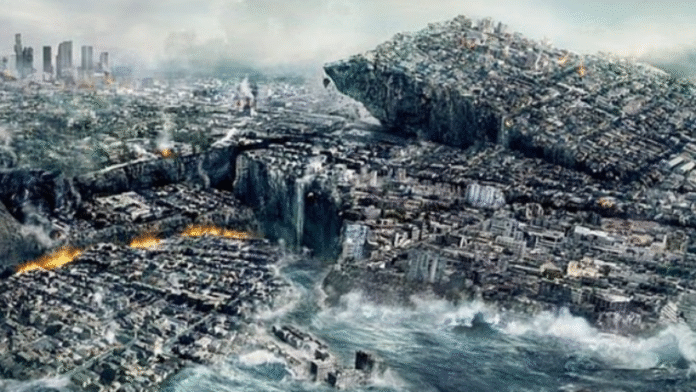Key Point Summary – Ring of Fire
- The 8.8 quake near Russia may spark volcanoes across the Pacific arc
- Scientists warn volcanoes in Japan, Russia, and Indonesia are at risk
- Hawaii flooded as tsunami waves over 5 feet crash ashore
- Klyuchevskoy volcano already erupting after the quake
- Elevated eruption risk to last up to two years, say experts
Millions At Risk After Record Quake Hits Russia
A colossal 8.8-magnitude earthquake off Russia’s Kamchatka Peninsula has triggered fears of a catastrophic domino effect across the Pacific Ocean’s notorious “Ring of Fire.” This volatile region, home to 75% of the world’s volcanoes, may now be facing a ticking time bomb of eruptions and tsunamis that could threaten millions.
The quake — the strongest globally in 14 years — rocked the seabed just 84 miles off the Russian coast, unleashing waves of panic and real tsunami waves across the Pacific. In Hawaii, water receded dramatically before crashing ashore in waves exceeding five feet, flooding coastal areas on Oahu.
Quake Could Trigger Volcanoes in Japan, Indonesia
Experts warn that this seismic shock could destabilize magma chambers far beyond the quake’s epicenter. According to geoscientist Michael Manga of UC Berkeley, the ripple effect could raise the likelihood of volcanic eruptions across nations bordering the Pacific — especially those closest to the quake zone like Russia, Japan, Indonesia, and the Philippines.
“These aren’t random eruptions,” Manga said. “When earthquakes of this magnitude strike, they change underground pressures. That can awaken volcanoes already simmering under the surface.”
He pointed to the eruption of Russia’s Klyuchevskoy volcano as a possible example. Explosive activity and lava flows were observed just hours after the quake hit.
Klyuchevskoy Blows After Weeks Of Tension
Known as one of the tallest active volcanoes on Earth, Klyuchevskoy rises more than 15,000 feet into the sky. Its eruption isn’t just coincidental. Satellite thermal readings from May already showed magma rising. The earthquake may have simply flipped the switch.
Observers saw ash and lava streams on the western flanks of the volcano, with explosive bursts that shook the Kamchatka skies. Scientists expect activity to continue in the coming days.
Kamchatka, dubbed the “Land of Fire and Ice,” houses 300 volcanoes — 29 of which are currently active. And with its close proximity to the quake’s epicenter, experts fear more could erupt.
Tsunami Hits Hawaii As Islands Brace For Aftershocks
As the quake’s seismic waves sped across the Pacific, Hawaii was put on high alert. Coastal towns were evacuated in the early morning hours. Around 2:20 a.m. ET, waves taller than four feet battered Oahu’s north shore, reaching five feet shortly after and causing severe flooding.
Residents shared dramatic footage of water racing inland as authorities rushed to issue warnings. Though the immediate tsunami threat is fading, long-term concerns remain.
Volcano Risk Now Elevated Across The Pacific
While not every volcano is expected to blow, the risk has clearly increased. Manga explained that even a one-percent annual eruption chance could now be 1.1 percent — a modest-sounding jump, but meaningful in terms of global volcanic patterns.
The risk window may last two months to two years, depending on how underground magma systems respond. Volcanic eruptions are rarely instant — pressure, gas bubbles, and stress build silently over time.
Why Quakes Trigger Volcanoes
Large earthquakes send powerful seismic waves through the earth. These can disturb magma chambers, open fractures, or even stir up gas bubbles, making magma more likely to rise and erupt.
Volcanoes that are already “primed” — with magma near the surface — are the most vulnerable. That’s what makes the current situation along the Ring of Fire so concerning.
Alaska And Hawaii Volcanoes Now Under Watch
Even volcanoes farther from the epicenter are being monitored. Alaska’s Great Sitkin Volcano, for example, is under a “Watch” status as lava continues to bubble within its summit crater. The Alaska Volcano Observatory reported “low-level seismicity” and signs of rockfalls this week.
Meanwhile, Hawaii’s Kilauea — one of the world’s most active volcanoes — ended its most recent eruption just 10 days ago. Now, it too is under watch.
The USGS has warned of possible renewed gas emissions, volcanic glass particles in the air, and fresh tephra deposits from earlier blasts.
Ring Of Fire On Edge From Russia To Antarctica
The Ring of Fire isn’t a single place — it’s a sprawling 25,000-mile chain of volcanoes and earthquake zones. From Russia to Japan, down through Southeast Asia, across the Pacific to the U.S. West Coast, and even Antarctica — it’s all one giant, explosive system.
Its deep ocean trenches are formed by tectonic plates colliding and sliding beneath one another. These subduction zones are breeding grounds for disaster — and they are all interconnected.
Manga says U.S. volcanoes on the West Coast, including those in California and Oregon, are unlikely to erupt from this quake. But they’re still being closely monitored, given the heightened global tectonic activity.
Global Eyes On The Pacific As Pressure Builds
While scientists caution that the overall global eruption risk remains low, they agree the situation is worth watching — carefully and continuously. History has shown that one major quake can set off a series of devastating natural disasters.
And with 100+ volcanoes now closer to eruption across the Pacific, the world is bracing for what could be months — or even years — of volcanic unrest.




